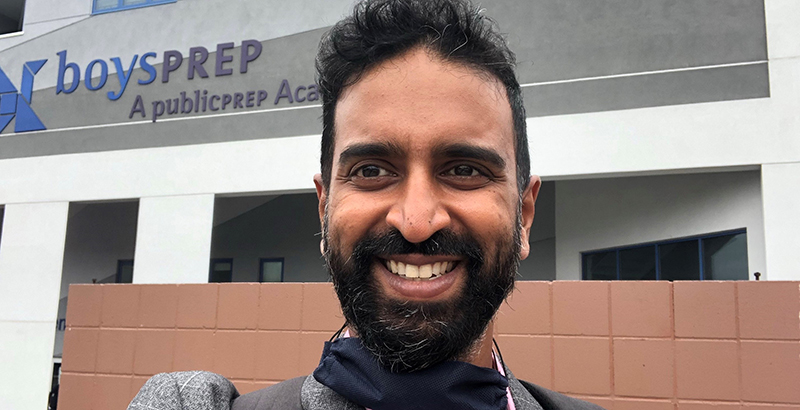Q&A — 3 Minutes With Equitable Facilities Fund CEO Anand Kesavan on Low-Cost, Long-Term Financing for High-Quality Charter Schools

This is one in an ongoing series of brief conversations with education innovators led by Greg Richmond, founder and former CEO of the National Association of Charter School Authorizers. His “Three Questions For” series also appears on Medium. Today’s edition: three minutes with Anand Kesavan, chief executive officer of the Equitable Facilities Fund, a nonprofit social-impact fund that offers low-cost, long-term facility financing for high-quality charter schools.
Richmond: As someone in facilities finance, you see schools through a different lens than most people in education. When you look at a school, what are you looking for, and is it different from what educators are looking at?
Kesavan: We’re investing for the long term, for 30-plus years. Because it’s such a long-term lens, there are a handful of things that are very different, that transcend annual metrics or the five-year renewal metrics. First would be the people and the culture. The second would be school quality. And third, which may be the one that’s the most unique compared to how educators may look at it, is long-term operational sustainability.
People and culture are where we start. It’s the community, the ecosystem of people who support the school. That includes the board members, community leaders, the founder and the C-level leadership team, the school leader, teachers — especially teachers who have been there for some time — students, parents, parent organizations, funders, local supporters and, of course, the authorizer, and many others who are part of that ecosystem.
We believe that strong people in ecosystems are an indication of long-term success and sustainability.
Second, school quality. Of course, everybody looks at this closely. We look at the big picture. Are our scholars better off in this school? How has that changed over time? Is there a really strong demand for this school? We will look at what parents are thinking, how enrollment looks, how wait lists look, and then try to project that over several years and what might change in time to either increase or decrease that demand.
We look at how the school itself measures quality. Every school model’s different. Is the school really focused on growth, or focused on proficiency, or both? Is the school focused on college prep, college persistence, lifetime vocational training? Then we’ll use the school’s own metrics to create metrics for success. We believe that schools that are very focused on hitting whatever metrics they define as success are the ones that are going to really thrive in the long term.
Third is long-term operational sustainability. I bucket that into a few things: financial metrics — and make no mistake, financial metrics matter — operating margin, fair and sustainable compensation, liquidity, making sure you have enough cash to pay the bills and making sure that, over a long period of time, not just this year, you have excess revenues over your expenses. We spent a lot of time at schools trying to make sure they set the right budgets, have a culture of hitting budgets, both this year and into the future.
Second in this bucket of operational sustainability is facilities. Facilities matter, specifically permanent facilities and permanent facilities financing. What are the risks they’re taking if they are going to be in a temporary site or have temporary financing?
And the third bucket, long-term operational sustainability, means we ask if the staffing model is sustainable. Is it affordable? Does it meet the academic needs of the school? Are those teachers and staff members actually available?
The charter schools you just described are academically and financially successful, and they are good, safe investments for you. But they could get funded by someone else if you did not exist. On the other hand, there are new operators with unproven schools who might turn out to be good, but they’re a higher risk for you. How do you think about the fact that schools that have the greatest need for low-cost financing are often the schools that are riskier and less likely to get financed?
I appreciate the question. I think it’s a good one. I would shift the question to think about the long term instead of just what’s happening today.
We’re unapologetic about advocating for what is best for schools and making our product the lowest-cost, permanent, long-term, lowest rate, simplest, no reserve requirements. In the short term, right now, we have the best product, but we’re not able to serve every school at the moment.
So, what we are doing right now is, we’re building our product so that it’s long-term, sustainable and scalable, so that we can make it a much larger fund. Then, when we’re larger, we can help a lot more people.
You spent more than a decade in traditional investment banking and then came to the nonprofit space. What can the private sector learn from the nonprofit space?
I love this question because I always get asked the opposite. It’s warming to my heart, and I’ll tell you why.
My mother was on the founding team of one of the early charter schools in Michigan back in the 1990s, and she’s still a leader there. I admire my mother so much. Very successful, strong, educated woman who worked in the district for several years and in the middle of her career decided to take on something very challenging by starting a charter school back when there weren’t a lot around. So I learned at an early age that some of the most successful and the most game-changing leaders are in the nonprofit sector because they chose to be.
I think of shining some light on what those banks can learn from Mom rather than the opposite. I’ll tell you what I learned from Mom, and it’s a couple of things. One, to start by focusing on the why. I don’t think this is something only for nonprofits. I think all companies need to think about what their role is in being responsible corporate citizens. Why do I do this work? What our mission is. What is our vision? We focus on that when it comes to hiring, when it comes to our team retreats, when it comes to sharing with our funders and our schools about who we are.
We are unapologetic about the “why” we do this work. And I think that a lot of nonprofits are very strong at this, and I’ve learned this by being in the nonprofit sector. In more than a decade in the private sector, I was almost never exposed to things like values and missions. So, I think that’s one thing the for-profit sector can learn from us.
Second, this focus on long-term, not just quarterly profits or annual metrics. I came from the investment banking world, and we were very interested in closing deals and the revenue potential of those deals. Maybe quarterly, maybe annually, not much longer than that. Whereas in my three jobs in the nonprofit sector, everything was thinking long-term. When I was at KIPP, we were thinking about how our second-graders were going to graduate from a four-year college, and we were backwards-mapping all our decisions to that. That was eye-opening to me, and it was humbling, and it was hard. But that is the game we are playing. The actions we’re taking only make sense if they work long-term. Otherwise, we’re not actually meeting our “why.”
I think the great corporations and great banks are the ones who are thinking long-term. For nonprofits, that’s not a luxury. That’s a necessity, right?
Get stories like these delivered straight to your inbox. Sign up for The 74 Newsletter

;)
